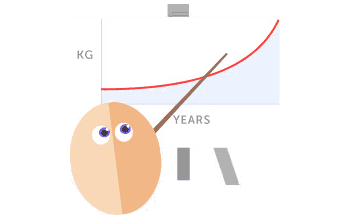A common question on this Forum is 'Why don't I lose weight?', followed by 'Why do I lose weight so slowly?' Enter TDEE
When I started roaming around this Forum, I kept running into the term TDEE. People used it quite a bit, and it seemed to have some relevance. I finally found Carorees 'Forum wiki' post, that defines many of the terms used on the site, including TDEE (thank you Carorees!). (see viewtopic.php?f=1&t=1133)
Quoting - "TDEE = total daily energy expenditure (how many calories you burn in one day and so how much you would need to eat to maintain your weight)".
Then I ran into the Progress Tracker, and it seemed to compute my TDEE for me. Being curious, I also looked for similar calculators on the web, and found several (a good one - http://www.mayoclinic.com/health/calori ... or/NU00598). Strangely, several gave me TDEE numbers quite different than that of the Progress Tracker - usually quite a bit higher. The variations seemed to center around my chosen activity level.
To determine my TDEE, I decided it better to guess at my correct activity level, and then choose the activity level one level below that (if possible). My reasoning was as follows.
First, TDEE is, after all, an estimate. So we are not talking precision here. Second, I know I usually overestimate how much activity I do over any given period of time. And third, I figured that if by underestimating I turned out actually to be right, my estimated weight loss would fall in line with reality (more on this later), but if I was wrong, I would lose more than expected and be much happier for exceeding my weight loss expectations. In effect, I would gain happiness by underestimating my activity level. And I am all for being happy!
So, how does TDEE help explain how 5:2 works?
Let us say you are a female with a TDEE of 2000 calories per day (about average, but everyone's is different) and are starting 5:2. Here is how you can compute your expected weight loss.
For two days a week, you will eat only 500 calories, thus cutting 3000 calories out of your diet for the week (2000 - 500 = 1500 calories cut in each of two days). As there are around 3500 calories in a pound, you might expect to lose about 14 ounces for the week (3000 cut from diet divided by 3500 in a pound times 16 ounces in a pound equals 14 ounces, rounded). These numbers tend to explain a lot.
First, they explain why the average weight loss is around a pound a week under 5:2.
Second, they explain why men lose faster than women - because on average a man's TDEE is 2400 calories per day (men often are bigger). So when they eat 600, they are cutting out 1800 calories from their diet and thus losing more each week than a woman cutting out 1500 calories.
Third, they explain why so many people following 5:2 try to speed things up. 14 ounces a week is pretty slow. Several typical attempts to speed things up include going to 4:3 (adding another fast day and deleting another 1500 calories from the week - this adds an additional 7 ounces of loss for the week), or not eating any calories on fast days (liquid fasting) - this cuts 1000 additional calories out, or produces a 5 ounce additional loss. Some people try to increase their calorie usage by exercising (trying to increase their TDEE). And, if they walk 25 miles each week, they will indeed burn an additional 3500 calories, thus upping their weekly loss to 30 ounces.
(As an aside, if you are really in a hurry you can simply not eat for a week, something this Forum rightfully shuns. But if you run the numbers, at most you will cut 14,000 cal. out of your diet, or 4 pounds worth - lest you really think you lost 4 or more pounds of fat weight after your first week of 5:2.)
Now, all of the above assumes that on your five feast days, you are eating 2000 calories per day on average. If you are eating more than your TDEE on average each week, your weight loss will be less than expected. If you are eating less, your weight loss will be more. This explains why many people doing 5:2 experiment with dieting on top of the 5:2 way of eating as a way of speeding up their weight loss (ie. follow the Atkins diet on their 5 feast days). This also explains why people that think 5:2 means you fast for two days and then can eat as much of whatever you want for the remaining 5 are usually quite unhappy and complain they are not losing weight.
Finally, all of these antiseptic numbers work with the background of normal fluid retention and dehydration in the body, either of which can overwhelm (or artificially supplement) any weight loss that is measured in ounces per week.
So, there we have it, TDEE in an (unscientific) nutshell. I guess all I can say is if you are having the results you want, ignore TDEE. If not, accurately determine your TDEE, insure your fast day calories do not exceed 5/600 and count calories on feast days to see if they average your TDEE or below. That will probably identify the problem. Otherwise
BE PATIENT!
It really does work over time.
When I started roaming around this Forum, I kept running into the term TDEE. People used it quite a bit, and it seemed to have some relevance. I finally found Carorees 'Forum wiki' post, that defines many of the terms used on the site, including TDEE (thank you Carorees!). (see viewtopic.php?f=1&t=1133)
Quoting - "TDEE = total daily energy expenditure (how many calories you burn in one day and so how much you would need to eat to maintain your weight)".
Then I ran into the Progress Tracker, and it seemed to compute my TDEE for me. Being curious, I also looked for similar calculators on the web, and found several (a good one - http://www.mayoclinic.com/health/calori ... or/NU00598). Strangely, several gave me TDEE numbers quite different than that of the Progress Tracker - usually quite a bit higher. The variations seemed to center around my chosen activity level.
To determine my TDEE, I decided it better to guess at my correct activity level, and then choose the activity level one level below that (if possible). My reasoning was as follows.
First, TDEE is, after all, an estimate. So we are not talking precision here. Second, I know I usually overestimate how much activity I do over any given period of time. And third, I figured that if by underestimating I turned out actually to be right, my estimated weight loss would fall in line with reality (more on this later), but if I was wrong, I would lose more than expected and be much happier for exceeding my weight loss expectations. In effect, I would gain happiness by underestimating my activity level. And I am all for being happy!
So, how does TDEE help explain how 5:2 works?
Let us say you are a female with a TDEE of 2000 calories per day (about average, but everyone's is different) and are starting 5:2. Here is how you can compute your expected weight loss.
For two days a week, you will eat only 500 calories, thus cutting 3000 calories out of your diet for the week (2000 - 500 = 1500 calories cut in each of two days). As there are around 3500 calories in a pound, you might expect to lose about 14 ounces for the week (3000 cut from diet divided by 3500 in a pound times 16 ounces in a pound equals 14 ounces, rounded). These numbers tend to explain a lot.
First, they explain why the average weight loss is around a pound a week under 5:2.
Second, they explain why men lose faster than women - because on average a man's TDEE is 2400 calories per day (men often are bigger). So when they eat 600, they are cutting out 1800 calories from their diet and thus losing more each week than a woman cutting out 1500 calories.
Third, they explain why so many people following 5:2 try to speed things up. 14 ounces a week is pretty slow. Several typical attempts to speed things up include going to 4:3 (adding another fast day and deleting another 1500 calories from the week - this adds an additional 7 ounces of loss for the week), or not eating any calories on fast days (liquid fasting) - this cuts 1000 additional calories out, or produces a 5 ounce additional loss. Some people try to increase their calorie usage by exercising (trying to increase their TDEE). And, if they walk 25 miles each week, they will indeed burn an additional 3500 calories, thus upping their weekly loss to 30 ounces.
(As an aside, if you are really in a hurry you can simply not eat for a week, something this Forum rightfully shuns. But if you run the numbers, at most you will cut 14,000 cal. out of your diet, or 4 pounds worth - lest you really think you lost 4 or more pounds of fat weight after your first week of 5:2.)
Now, all of the above assumes that on your five feast days, you are eating 2000 calories per day on average. If you are eating more than your TDEE on average each week, your weight loss will be less than expected. If you are eating less, your weight loss will be more. This explains why many people doing 5:2 experiment with dieting on top of the 5:2 way of eating as a way of speeding up their weight loss (ie. follow the Atkins diet on their 5 feast days). This also explains why people that think 5:2 means you fast for two days and then can eat as much of whatever you want for the remaining 5 are usually quite unhappy and complain they are not losing weight.
Finally, all of these antiseptic numbers work with the background of normal fluid retention and dehydration in the body, either of which can overwhelm (or artificially supplement) any weight loss that is measured in ounces per week.
So, there we have it, TDEE in an (unscientific) nutshell. I guess all I can say is if you are having the results you want, ignore TDEE. If not, accurately determine your TDEE, insure your fast day calories do not exceed 5/600 and count calories on feast days to see if they average your TDEE or below. That will probably identify the problem. Otherwise
BE PATIENT!
It really does work over time.


 that should explain to everyone how it's done
that should explain to everyone how it's done  Sue
Sue
 but i have a question about weight loss whilst on the 5.2, i started just a little over 2 weeks ago and done 4 fasts so far, i exercise regularly too and eat healthy most the other days lol, so am wondering, when does the weight start to come off? after the fisrt week, second? because even though i hadnt weighed myself for well over 2 years i did this morning and i havent lost anything! i dont want a major weight loss, maybe 1 stone will be enough for me,( i am a size 10,7 years ago i was a 16) doing this mainly for the health benefits, i know i am loosing inches because of the way my clothes fit etc... anyway sorry for the rant! just would like some input on this, much appreciated and thank you for reading!!!!!!!
but i have a question about weight loss whilst on the 5.2, i started just a little over 2 weeks ago and done 4 fasts so far, i exercise regularly too and eat healthy most the other days lol, so am wondering, when does the weight start to come off? after the fisrt week, second? because even though i hadnt weighed myself for well over 2 years i did this morning and i havent lost anything! i dont want a major weight loss, maybe 1 stone will be enough for me,( i am a size 10,7 years ago i was a 16) doing this mainly for the health benefits, i know i am loosing inches because of the way my clothes fit etc... anyway sorry for the rant! just would like some input on this, much appreciated and thank you for reading!!!!!!!



